
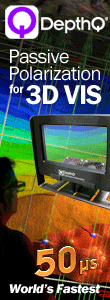

Stereoscopic Displays and Applications XXXI (2020)
Conference Proceedings
Proceedings of the Electronic Imaging Symposium
| This proceedings introduction is published as a full SD&A proceedings manuscript which can be cited as: A.J. Woods, N.S. Holliman, G.E. Favalora, T. Kawai, B. Sommer "31st Annual Stereoscopic Displays and Applications Conference - Introduction," in IS&T Electronic Imaging: Stereoscopic Displays and Applications XXXI, (IS&T, Springfield, VA, 2020). DOI: https://doi.org/10.2352/ISSN.2470-1173.2020.2.SDA-B02 Download PDF. |
31st Annual Stereoscopic Displays and Applications Conference - Introduction
Andrew J. Woods1, Nicolas S. Holliman2, Gregg E. Favalora3, Takashi Kawai4, Björn Sommer5
1Curtin University, Australia; 2Newcastle University, United Kingdom; 3Draper, USA; 4Waseda University, Japan; 5Royal College of Art, United Kingdom.
Abstract
This document provides an overview of the 31st Stereoscopic Displays and Applications conference and an introduction to the conference proceedings.
Introduction
The 31st annual Stereoscopic Displays and Applications conference was held at the Hyatt Regency San Francisco Airport hotel in Burlingame, California over the period 27-29 January 2020. This introduction provides a summary of the wide range of activities and events that take place at the conference. The conference attracts a strong mix of attendees from both industry and academia including those who spoke in the plenaries, keynotes and technical sessions.
This year the conference had 28 oral presentations across the three days of the conference. Three of the conference sessions were held jointly with other Electronic Imaging Symposium conferences – the Human Vision and Electronic Imaging conference (HVEI) Engineering Reality of Virtual Reality conference (ERVR), and the Imaging Sensors and Systems conference (ISS).
The final conference program is available on the long-standing SD&A conference website: www.stereoscopic.org/2020 The program page also lists which presentations have an accompanying manuscript (and where to find it) and those that don’t. Some of the papers are published in the Journal of Imaging Science and Technology (JIST) and are indicated with the designation “JIST first” since manuscripts submitted this way go through an accelerated full review process.
All of the published manuscripts from SD&A 2020 along with the other papers from the 2020 Electronic Imaging Symposium will be published in the IS&T Digital Library at: https://library.imaging.org/ei/volumes Papers in the joint sessions can only appear in one proceedings volume so they may appear in the proceedings volume of one of the contributing conferences rather than the SD&A proceedings. The SD&A 2020 program page will provide a direct link to each of the manuscripts without needing to worry about which particular conference or journal site they appear in – just visit:
www.stereoscopic.org/2020
All manuscripts from the SD&A 2020 conference and the wider Electronic Imaging Symposium are published Open Access which significantly improves the accessibility of SD&A authors’ work and help you, the reader, access new and important developments in this field.
A technical short course also runs on the day before the conference to provide conference attendees with a base level of understanding of stereoscopic imaging technologies and techniques.First Day
The first day of the conference had two technical sessions: Human Factors in Stereoscopic Displays (a joint session with the Human Vision and Electronic Imaging conference), and Autostereoscopy I (Autostereoscopic displays are the holy grail in this field and we expect there will always be sessions on autostereoscopic displays at SD&A). The full listing of conference papers presented at the conference is listed on the conference program web page:
www.stereoscopic.org/2020
The Monday Electronic Imaging (EI) Symposium Plenary was presented by Assistant Professor Katie Bouman from Caltech on the amazing feat of taking the first picture of a black hole from the Event Horizon Telescope. The talk opened with an amazing animated visualisation of the scale of the imaging achievement and an illustration of the processes allowing the black hole to be seen. The talk was detail rich and took the audience on this journey with ease. The EI Symposium was also very pleased to be able to award Professor Bouman with the 2020 Electronic Imaging Scientist of the Year Award! See Figure 1. This plenary presentation was recorded and will be made available via the Electronic Imaging YouTube channel:
https://www.youtube.com/channel/UCShYQ9u43HNmeBEcicVbbWg
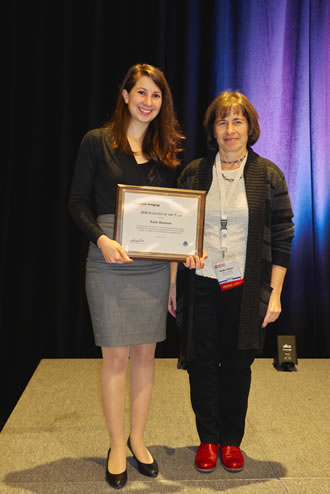
Figure 1: Katie Bouman receives the Electronic Imaging Scientist of the Year award from EI2020 chair Radka Tezaur. Photo: Dietmar Wüller.
The first SD&A Keynote Presentation was given by Larry Paul, Executive Director of Technology and Custom Solutions, Enterprise and Entertainment at Christie Digital Systems (USA). His presentation was titled: "High frame rate 3D-challenges, issues and techniques for success”. The presentation discussed the wide range of challenges, issues and successes in creating, displaying and experiencing high-quality 3D content for audiences worldwide. The presentation also included the presentation of a short clip from “Gemini Man” in 60fps High-Frame-Rate 3D using a wonderfully bright Christie 3D projector.
There was a standby presentation presented on Monday to replace a withdrawn paper. The presentation “Remastering 360˚ 3D videos into 16:9 3D format” by Andrew Woods was a summary of 360˚ 3D techniques used on two 3D films that would show later that evening in the 3D Theater session.
The day also included the Electronic Imaging Symposium reception, the annual SD&A 3D Theater Session, and the SD&A conference dinner.
The 3D Theater Session is a regular highlight of the conference that showcases 3D content from around the world. This year, the following pieces (or segments thereof) were screened:
Competition Category:
- “Alien Gardens” – John Hart (USA)
- “Dariya Khan Lohani in 3D” – Royal Tech Media Private Limited (India)
- “ENT3D Project Explained” – Peter J. Casano, M.D. (USA)
- “Feline Paradox” – Ben Reicher (USA)
- “Fire on the Water” – Produced and Directed by Robyn Johnston for Shire of Shark Bay from footage courtesy of Curtin University and Western Australian Museum (Australia)
- “Ghosts of the Pastures” – Christian A. Zschammer (Germany)
- “Impact: Beyond the Night Sky” – Kath Dooley (Australia)
- “Interrupted Dreams” – Aleksey Osipenkov (Russia)
- “Little Planet in Stereoscopic 3-D” – STEREOeYe / Takashi Sekitani (Japan)
- “Memory of Ice Jökulls – Melting Glaciers, Iceland” – Ikuo Nakamura (USA)
- “Pancake Day” – Andrew Hurst (UK)
- “Parallax Garden” – Volker Kuchelmeister (Australia)
- “Platform – Notting Hill Gate” – Karel Bata (UK)
- The Bored Alligator – Caiman Yacare” – Hélio Souza (Brazil)
- “The Stereoscopic Society 125 Years International History” – Andrew Hurst (UK)
- “Triangle in the Sky (Part 1)” – Richard Connew (UK)
- “Zenobia, 102 Lorries Under the Sea” – Michel Patient (France)
- “Zerynthia Expedition 2” – Concept, Video, and Music by J-Walt (USA)
Demonstration Category:
- “Australia's Great Wild North trailer” – Caspar Mazzotti, Electra Manikakis, Nick Robinson (Australia)
- “Captain Marvel” – Marvel Studios (USA)
- “DepthQ 3D Polarization Modulator Trailer” – Lightspeed Design, Inc. (USA)
- “El Corazón y la Espada (from 1953)” – Restored by 3-D Film Archive for 3-D RARITIES II (Mexico)
- “Foit Yet Cleem Triavith” – Peter Rose (USA)
- “Gemini Man” – Director: Ang Lee (USA)
- “Hidden Pacific” – Ian Shive (USA)
- “Le Mans Trailer” – Fabien Remblier (France)
- “Next Gen” – Joe Ksander and Kevin R. Adams (USA / China)
- “Secrets of the Universe” – Stephen Low Company (Canada)
- “The Lion King” – Walt Disney Pictures (USA)
- “Toy Story 4” – Pixar Animation Studios (USA)
We wish to thank all of the contributors who kindly allowed their 3D content to be screened at this 90-minute event. All entries were screened in high quality polarized 3D on the conference’s large-screen projection system provided by Christie Digital Systems and DepthQ Stereoscopic.
The producers of the 2020 SD&A 3D Theater were John Stern (retired), Dan Lawrence (Lightspeed Design), Chris Ward (Lightspeed Design), and Andrew Woods (Curtin University).
We are grateful for the support of our projection sponsors, DepthQ Stereoscopic and Christie Digital; and our 3D Theater partners, LA 3-D Movie Festival and 3-D Film Archive.
The judges at this year’s event were:
• Bob Whitehill, Stereoscopic Supervisor at Disney Pixar
• Larry Paul, Executive Director - Technology and Custom Solutions Enterprise and Entertainment at Christie Digital
• Eric Kurland, Founder at 3-D Space and producer of the LA 3-D Movie Festival
This year the judges chose the following 3D content winners:
Best-of-Show Live Action category:
“Little Planet in Stereoscopic 3-D”
– Takashi Sekitani, STEREOeYe (Japan)
Takashi Sekitani is a stereoscopic 3D photographer and 3D / 3D 180˚VR / 3D360˚VR videographer based in Tokyo, Japan. For more of Mr. Sekitani’s works, see: http://www.stereoeye.jp See Figure 2 for a thumbnail of this piece.
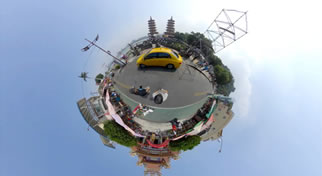
Figure 2. "Little Planet in Stereoscopic 3-D" – Takashi Sekitani, STEREOeYe (Japan), Best of Show 3D live-action.
Best-of-Show Animation category:
“Interrupted Dreams” – Aleksey Osipenkov (Russia)
Aleksey Osipenkov is an animated 3D film creator based in Moscow, Russia. He is currently involved in the series "Masha and the Bear". For more of Mr. Osipenkov’s works, see: http://www.imdb.com/name/nm3055035 See Figure 3 for a thumbnail of this film.
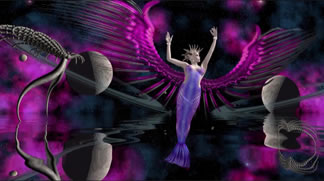
Figure 3. "Interrupted Dreams" – Aleksey Osipenkov (Russia), Best in Show Animation.
Best-of-Show Hybrid Live-Action / Animation Category:
“ENT3D Project Explained” – Peter J. Casano, M.D. (USA)
Dr. Casano is an ENT physician based in Jackson, Mississippi. In addition to his regular medical practice he creates educational materials which you may find on his website: http://petercasano.com See Figure 4 for a thumbnail.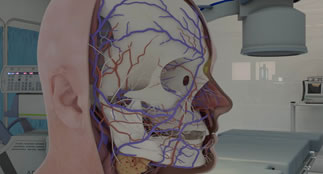
Figure 4. “ENT3D Project Explained” – Peter J. Casano, M.D. (USA). Best in Show Hybrid Live-Action / Animation Category.
The evening concluded with the SD&A conference dinner at Original Max's Restaurant and Bar in Burlingame - a short walk from the conference hotel. The conference dinner always provides a relaxed opportunity to socialize with other conference attendees.
Second Day
The second day of the conference had three technical sessions: Autostereoscopy II, Stereoscopic Image Processing, and 3D Developments. The day also included the second Symposium Plenary, the second SD&A Keynote, and the symposium-wide Demonstration Session.
The second all-of-symposium EI Plenary was presented by Gary Hicok, Senior Vice President of hardware development at NVIDIA (USA) with the title “Imaging in the Autonomous Vehicle Revolution”. These days you will see many self-driving vehicles ‘in-training’ around the San Francisco Bay Area. Mr. Hicok’s presentation detailed the wide range of technologies which are being used to power these developments from imaging systems and cameras, to high-performance hardware mobile compute platforms, to advanced image processing software solutions using deep learning. This plenary presentation was recorded and will be made available via the Electronic Imaging YouTube channel mentioned previously.
The Tuesday SD&A keynote, titled “Challenges and solutions for multiple viewer stereoscopic displays” was delivered by Kurt Hoffmeister, Co-Founder and Technology Consultant at Mechdyne Corporation (USA). Mr Hoffmeister’s presentation reviewed the many challenges and solutions of delivering high-quality and undistorted stereoscopic imagery to multiple users using immersive display systems. The presentation discussed the need for multi-viewer solutions as a key challenge for stereoscopic displays and multiple participant applications.
During the EI conference awards session, the Charles E. Ives Award for Best Paper in an IS&T Journal was awarded to Jukka Häkkinen from University of Helsinki (Finland) for the paper “Time Course of Sickness Symptoms with HMD Viewing of 360-degree Videos” – Journal of Imaging Science and Technology, Vol 62 #6 (see Figure 5). Co-authors on the paper were Fumiya Ohta and Takashi Kawai. This paper was presented the 2019 Stereoscopic Displays and Applications conference as a JIST-First publication. Both Dr Häkkinen and Professor Kawai are regular authors at SD&A.
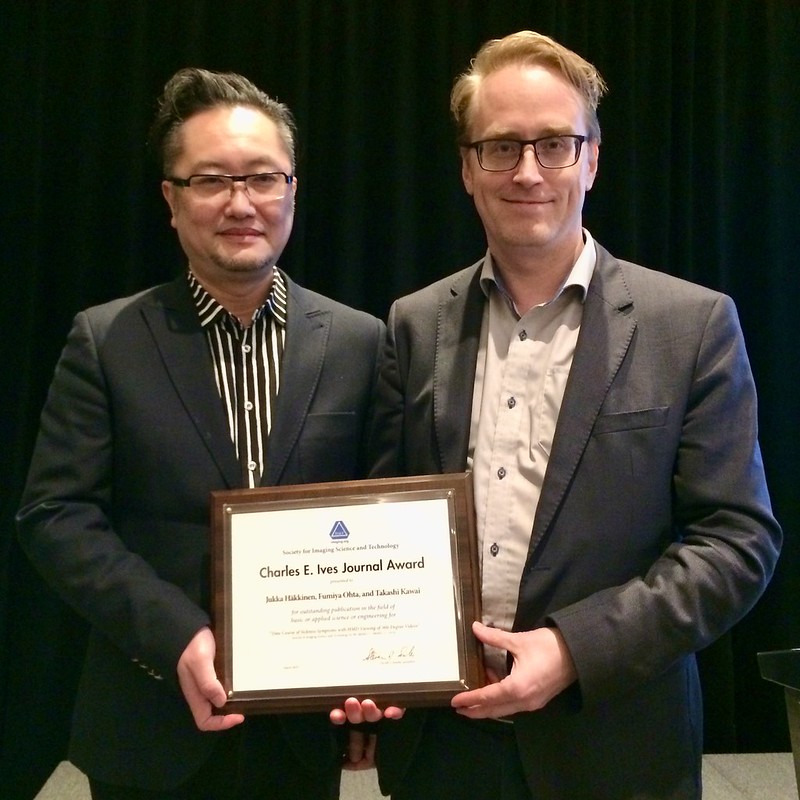
Figure 5. Professor Takashi Kawai and Jukka Häkkinen with the Charles E. Ives Award. Photo: Andrew Woods.
There was a standby presentation presented today from Eric Kurland from 3-D Space titled “Update from the 3-D SPACE Museum – A 2nd Case Study” – in session 4 presentation 5. There will be more discussion about this presentation later.
On Tuesday evening, the demonstration session was busy with enthusiastic conference attendees.
The following stereoscopic related demonstrations were presented at the session:
- Nicholas Routhier from Mindtrick Innovations Inc. (Canada) demonstrated CubicSpace – a software solution for ‘proportional, comfortable and universal’ capture and display of stereoscopic content. The software was demonstrated using a Lenovo Mirage VR180 3D camera, a RokIT IO Pro autostereoscopic 3D phone, and also a PC version of the software running on a laptop in anaglyph 3D.
- Bernard Mendiburu from Varjo (Finland and USA) presented the brand new Varjo XR-1 head-mounted-display which is an industrial grade VR/AR/XR device combining a very high resolution display with an amazing video-see-through experience (Figure 6).
- Eric Kurland from 3-D SPACE (USA) demonstrated the 8” Looking Glass Factory lightfield autostereoscopic 3D display with stereoscopic x-ray imagery created in the J. Paul Getty Museum's radiology laboratory, and also photographed new 3D content for the Looking Glass using a Weeview SID stereoscopic camera and processed using the Stereo Photo Maker software from Masuji Suto in Japan. Audience members were keen to see themselves in 3D on the Looking Glass Display (Figure 7).
- Bjorn Sommer from Royal College of Art, London (United Kingdom) demonstrated - as an example for Immersive Design Engineering - the LITHO, an Augmented Reality 3D interaction device which was paired with an iPhone during the demo session. The development of this device was initiated by Nat Martin during his Master studies on Innovation Design Engineering at the RCA/Imperial College London.
- Andrew Woods from Curtin University (Australia) demonstrated the steak cooking VR simulation for spinal cord injury rehabilitation purposes on an Oculus Quest HMD, and the 360˚ 3D short film “Impact: Beyond the Night Sky”.
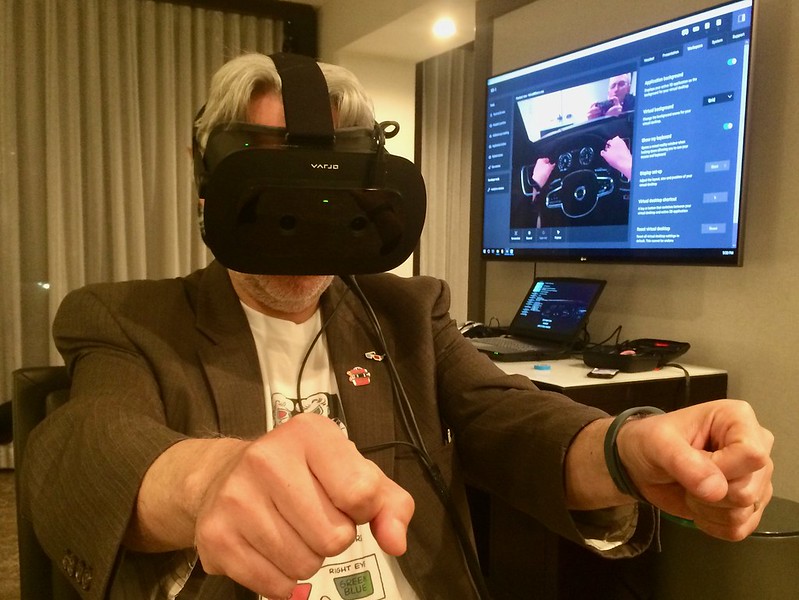
Figure 6. Eric Kurland drives a virtual Volvo car using the new Varjo XR-1 head-mounted-display with video-see-through capability. On the display in the background you can see Eric holding the steering wheel and looking through the windscreen at the photographer. Also worth noting are Eric’s 3D pins and 3D T-shirt. Image: Andrew Woods.
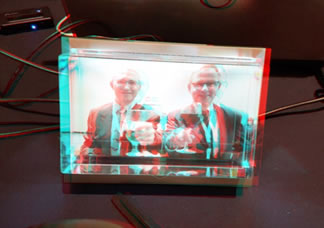
Figure 7. Andrew Woods and Justus Ilgner in 3D on the Looking Glass Display presented here in anaglyph 3D. NB: the actual display is full-colour autostereoscopic 3D. 3D photo and image processing of image shown on Looking Glass Display: Eric Kurland. Anaglyph 3D photo of Looking Glass Display: Bjorn Sommer.
Additionally, Justus Ilgner was spotted touring a Vuze+ 360˚ 3D video camera around the session, and we have the footage!
The demonstration session was curated by Bjorn Sommer (Royal College of Art, London) and Donna Smith (IS&T).
As with every year, there were also a number of demo presentations from other conferences which enriched the program for all attendees.
A selection of photographs from the demonstration session will be available via the SD&A conference website www.stereoscopic.org
Third Day
The third day of the SD&A conference had two technical sessions, two keynotes, and one plenary presentation. The two technical sessions were: “Stereoscopic Perception and VR” and “Visualization Facilities” (joint with the ERVR conference).
The day started with a joint keynote presentation between the Imaging Sensors and Systems (ISS) and the Engineering Reality of Virtual Reality (ERVR) conferences. Christoph Leuze from Stanford University (USA) presented “Mixed reality guided neuronavigation for non-invasive brain stimulation treatment” which included numerous examples of medical applications of the Microsoft Hololens and the Magic Leap One.
The third and final all-of-symposium EI plenary presentation was presented by Douglas Lanman, Director of Display Systems Research at Facebook Reality Labs (United States). His presentation was titled “Quality Screen Time: Leveraging Computational Displays for Spatial Computing” (see Figure 8). The presentation gave a wonderfully expansive overview of his recent five year R&D journey at Facebook. This plenary presentation was recorded and will be made available via the Electronic Imaging YouTube channel mentioned previously.
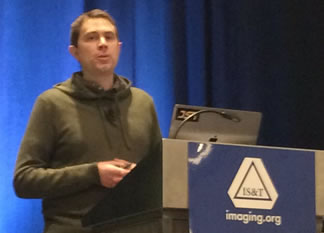
Figure 8. Doug Lanman (Facebook Reality Labs, USA) delivering his plenary presentation.. Photo: Andrew Woods
The final Keynote speaker for the 31st annual SD&A conference was Bruce Dell from Euclideon Holographics (Australia) who spoke about multi-user and head-tracked 3D Displays.
The third day concluded with the interactive paper / poster session. As always the room was very dynamic with authors kept busy with questions from the attendees.
Discussion
Most of the technical sessions at the SD&A conference were recorded. Subject to author permission, the content will be available via the SD&A conference website. Links will also be provided from the 2020 conference program page when available:
www.stereoscopic.org/2020/program.html
In addition to the prizes for the 3D Theater, a final prize was offered at the conference for the best use of stereoscopic presentation tools during the technical presentations – as chosen by the SD&A chairs.
The winner for the best use of the stereoscopic projection tools during the SD&A conference presentations was:
“Update from the 3-D SPACE Museum – A 2nd Case Study” by Eric Kurland from 3-D SPACE (USA).
Eric’s talk included a wide selection of stereoscopic visuals including a stereoscopic x-ray study of a three-dimensional artwork in cooperation with the J Paul Getty Museum. Eric pulled off this award-winning impromptu presentation with only 40 minutes notice, but of course off the back of many years of 3D experience and projects. Next year he only gets five minutes notice! ☺
Congratulations to all of our prize-winners.
Special thanks go to the many authors who integrated the use of stereoscopic display technology into their presentations using the conference’s large 3D projection screen! On the Wednesday in particular we had a flurry of 3D enabled presentations. We look forward to seeing an increasing the number of 3D presentations in the future! It is possible to easily mix 2D and 3D content in author presentations using PowerPoint, Keynote or any other presentation software you might prefer– or you may prefer to do the whole presentation in 3D like several authors have done in the past.
Many individuals and companies contributed to the success of this year’s SD&A conference:
- We appreciate the support of this year’s stereoscopic projection sponsors: DepthQ Stereoscopic by Lightspeed Design Group (USA), and Christie Digital (USA). The ability to present high-quality large-screen stereoscopic images and video at the conference is vital to the success of the conference.
- This year we had a Christie Digital Mirage 304K projector (1920 × 1080 resolution, 16:9 aspect ratio, 3 chip DLP outputting a massive 30,000 ANSI lumens from six lamps, provided by Christie Digital) projecting onto a 4.9 × 2.7 meter silvered screen (provided by STRONG / MDI Screen Systems), outputting frame-sequential circularly-polarized 3D (at 120Hz) by way of a DepthQ active polarization modulator (provided by Lightspeed Design). The system was driven by a DepthQ Stereoscopic Media Server for playback of all of the stereoscopic video content shown during the 3D Theater. Dan Lawrence from Lightspeed Design set up, configured and ran the 3D projection system.
- Many thanks to the staff from Spectrum Audio Visual led by Adrian Romero who provided audio-visual support on-site.
- Eric Kurland performed the role of SD&A AV Room monitor this year – supporting the presentation needs of all of our presenters.
- We are grateful to all of the providers of 3D content for allowing their content to be shown to the conference audience at the 3D Theater Session.
- Thanks to the demonstration session presenters for bringing equipment to show.
- The conference committee plays an important role throughout the year, ensuring the correct technical direction of the meeting. Sincere thanks go to our founding chair, John Merritt, and our committee: Neil Dodgson, Davide Gadia, Hideki Kakeya, Stephan Keith, Bjorn Sommer, John Stern and Chris Ward. (see Figure 9).
- Thanks also to the staff at IS&T - the organizing society instrumental in organizing all manner of aspects for the meeting – and in particular Suzanne Grinnan, Marion Zoretich, Ann McCarthy and Donna Smith.
- Most importantly, we thank the conference authors and attendees, who ultimately made this meeting such a successful event. Thanks especially to those who traveled a long way to attend the conference.
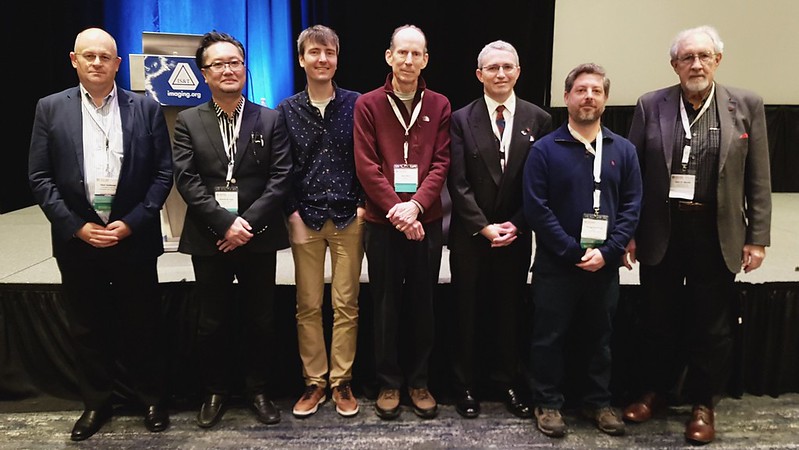
Figure 9. Some of the SD&A conference chairs and committee: (L-R) Nick Holliman, Takashi Kawai, Bjorn Sommer, John Stern, Andrew Woods, Gregg Favalora and John Merritt,. Photo: Justus Ilgner.
There will be some committee membership changes for our next SD&A conference with Stephan Keith, Hideki Kakeya and Davide Gadia rotating off the committee. We would all like to express our thanks to Stephan, Hideki and Davide for many years of service to the conference. Special mention needs to be mentioned of Stephan Keith’s tireless efforts performing the AV monitor role at the conference over many many years. New members joining the SD&A committee at this time are Dr. Justus Ilgner (University Hospital Aachen, Germany), Eric Kurland (3-D SPACE Museum, USA), and Professor Laurie Wilcox (York University, Canada). Justus, Eric and Laurie have all attended the conference many times and we look forward to harnessing their ideas and energy for continuing the important role of SD&A.
Conclusion
The SD&A conference website and LinkedIn group provide a focus for conference activities throughout the year. We will soon be actively seeking abstracts for next year’s conference – see the SD&A website www.stereoscopic.org for details and deadlines.
The conference website also has an extensive collection of photographs highlighting the activities of past conferences. In addition, the website hosts the stereoscopic virtual library, which contains several historically important books that have been digitized, in full, into PDF format, and are available for free download.
The SD&A conference runs an active LinkedIn group which is available at:
www.linkedin.com/groups?gid=1945944
At one stage LinkedIn was limiting its email notification so if you’re not a regular user of LinkedIn and you would like to be kept up-to-date with SD&A conference activities via email, it would be good to check your notification settings and perhaps sign-up to our conference mailing list. Visit here to sign up:
https://lists.curtin.edu.au/mailman/listinfo/sdalist
The 2020 conference was live-Tweeted by @SDnAconf and other attendees. Check out the conference Twitter feed for details:
https://twitter.com/SDnAconf
Photographs from this year’s conference are already available in a special album on Flickr:
https://flic.kr/s/aHsmLWrGfv
You can visit the conference website to gain an understanding of the past, present, and future of stereoscopic imaging. Please think now about submitting a paper or attending the next SD&A conference.
The Stereoscopic Displays and Applications conference website is at:
www.stereoscopic.org
Next year’s Electronic Imaging Symposium and SD&A conference will be held during the period 17-21 January 2021 as part of annual IS&T Electronic Imaging Symposium, again at the Parc 55 San Francisco hotel in downtown San Francisco. The closest airport is San Francisco International (SFO) with a wide range of transport options available between the hotel and the airport, including BART (Bay Area Rapid Transport).
The 2021 SD&A conference will continue a tradition of presenting and demonstrating the latest technologies relevant to stereoscopic displays and applications. Please consider attending, presenting, or demonstrating at the 2021 event. We hope to see you there!
Author Biographies
Andrew Woods is an Associate Professor at Curtin University where he manages the HIVE Visualisation Facility and is a Research Engineer at the Centre for Marine Science & Technology. His research interests are in stereoscopic 3D imaging, visualisation, 3D reconstruction, 3D cameras and displays, video electronics, underwater vehicles (ROVs), and engineering software development, with applications in offshore oil and gas, and maritime archaeology. He has BEng and MEng degrees in electronic engineering and his PhD was on the topic of crosstalk in stereoscopic displays.
Nick Holliman is Professor of Visualization at Newcastle University researching the science and engineering of visualization and visual analytics including the fundamental challenges of visualizing big data. This includes working with psychologists to understand how the human visual system processes information, developing novel computational algorithms for the control of image content and demonstrating how these algorithms work in practice in cloud-based software tools and award winning stereoscopic 3D visualizations. He has worked in both industrial and academic environments and is experienced in delivering commercial impact from research outputs.
Gregg Favalora is Principal Member Technical Staff at Draper (Cambridge, MA, USA) in the Division of Positioning, Navigation and Timing. He holds a BS (EE) from Yale University and an SM from Harvard University. From 1997 - 2009, Gregg was CTO of autostereoscopic display developer Actuality Systems, Inc., which created the Perspecta volumetric display and other advances in visualization.
Takashi Kawai is a Professor in the Department of Intermedia Art and Science, Faculty of Science and Engineering, Waseda University, Japan. He received his Ph.D., M.A. and B.A. in Human Sciences from Waseda University in 1998, 1995 and 1993, respectively. His research interests include ergonomics and human factors in advanced imaging technologies such as stereoscopic imaging, virtual / augmented / mixed reality and cross-modal systems. He is a Certified Professional Ergonomist (CPE).
Bjorn Sommer is a Research Tutor at the Royal College of Art (London) in the Innovation Design Engineering program. He is working on Immersive Analytics of collective behavior as well as mesoscopic and molecular data modeling and visualization. He has experience since more than a decade in the development of 3D-stereoscopic applications. He holds a B. Sc. in Media Informatics, an M.A. in Interdisciplinary Media Sciences, and a PhD in Bioinformatics from Bielefeld University. From 2015-2016 he was working as a Research Fellow at Monash University (Melbourne), and from 2016-2019 at the University of Konstanz.
